Analysis of the Observed Trends in Rainfall and Temperature Patterns in North-Eastern Nigeria
Abstract
1. Introduction
2. Material and Methods
2.1. Study Area
2.2. Data Sources and Analysis
2.3. Mann-Kendell Test
2.4. Sen’s Slope Estimator (SSE)
2.5. Auto-Correlation Test
2.6. Sen Innovative Trend Analysis (Sen_ITA)
2.7. Modified Mann–Kendall Test
2.8. Inverse Distance Weighting Interpolation of Rainfall and Maximum/Minimum Temperature for Adamawa, Borno and Gombe States
3. Results
3.1. Result of Autocorrelation Test
3.2. Rainfall Trend in Some Selected Stations in Northeast, Nigeria
3.3. Maximum Temperature Trend in Some Selected Stations in Northeast, Nigeria
3.4. Minimum Temperature Trend in Some Selected Stations in Northeast, Nigeria
4. Result of Inverse Distance Weighting Interpolation of Rainfall and Maximum/Minimum Temperature for Adamawa, Borno and Gombe States
4.1. Mean Annual Rainfall
4.2. Mean Annual Maximum Temperature
4.3. Mean Annual Minimum Temperature
5. Discussion
6. Conclusions
Supplementary Materials
Author Contributions
Funding
Data Availability Statement
Acknowledgments
Conflicts of Interest
References
- Megersa, B.; Markemann, A.; Angassa, A.; Ogutu, J.O.; Piepho, H.P.; Zaráte, A.V. Impacts of Climate Change and Variability on Cattle Production in Southern Ethiopia: Perceptions and Empirical Evidence. Agric. Syst. 2014, 130, 23–34. [Google Scholar] [CrossRef]
- Boudiaf, B.; Dabanli, I.; Sen, Z. Temperature and Precipitation Risk Assessment under Climate Change Effect in Northeast Algeria. Earth Syst. Environ. 2020, 4, 1–14. [Google Scholar] [CrossRef]
- Adeola, O.A.; Adeyemi, O.; Onyemaenu, V. Rainfall-Runoff in Conterminous Tropical River Basins of Southwestern Nigeria. Afr. Geogr. Rev. 2021, 42, 14–28. [Google Scholar] [CrossRef]
- Maharana, P.; Agnihotri, R.; Dimri, A.P. Changing Indian Monsoon Rainfall Patterns under the Recent Warming Period 2001–2018. Clim. Dyn. 2021, 57, 2581–2593. [Google Scholar] [CrossRef]
- Williams, M.R.; King, K.W. Changing rainfall patterns over the Western Lake Erie Basin (1975–2017): Effects on tributary discharge and phosphorus load. Water Resour. Res. 2020, 56, e2019WR025985. [Google Scholar] [CrossRef]
- Mu, D.; Luo, P.; Lyu, J.; Zhou, M.; Huo, A.; Duan, W.; Nover, D.; He, B.; Zhao, X. Impact of Temporal Rainfall Patterns on Flash Floods in Hue City, Vietnam. J. Flood Risk Manag. 2021, 14, e12668. [Google Scholar] [CrossRef]
- Shahfahad Talukdar, S.; Islam, A.R.M.T.; Das, T.; Naikoo, M.W.; Mallick, J.; Rahman, A. Application of advanced trend analysis techniques with clustering approach for analyzing rainfall trend and identification of homogenous rainfall regions in Delhi metropolitan city. Environ. Sci. Pollut. Res. 2023, 30, 106898–106916. [Google Scholar] [CrossRef]
- Eingrüber, N.; Korres, W. Climate Change Simulation and Trend Analysis of Extreme Precipitation and Floods in the Mesoscale Rur Catchment in Western Germany until 2099 Using Statistical Downscaling Model (SDSM) and the Soil & Water Assessment Tool (SWAT Model). Sci. Total Environ. 2022, 838, 155775. [Google Scholar]
- Ibebuchi, C.C. Patterns of Atmospheric Circulation in Western Europe Linked to Heavy Rainfall in Germany: Preliminary Analysis into the 2021 Heavy Rainfall Episode. Theor. Appl. Climatol. 2022, 148, 269–283. [Google Scholar] [CrossRef]
- Zittis, G.; Bruggeman, A.; Lelieveld, J. Revisiting future extreme precipitation trends in the Mediterranean. Weather. Clim. Extrem. 2021, 34, 100380. [Google Scholar] [CrossRef]
- McKay, R.C.; Boschat, G.; Rudeva, I.; Pepler, A.; Purich, A.; Dowdy, A.; Hope, P.; Gillett, Z.E.; Rauniyar, S. Can southern Australian rainfall decline be explained? A review of possible drivers. Wiley Interdiscip. Rev. Clim. Chang. 2023, 14, e820. [Google Scholar] [CrossRef]
- Zhang, F.; Biederman, J.A.; Dannenberg, M.P.; Yan, D.; Reed, S.C.; Smith, W.K. Five decades of observed daily precipitation reveal longer and more variable drought events across much of the western United States. Geophys. Res. Lett. 2021, 48, e2020GL092293. [Google Scholar] [CrossRef]
- Hanif, M.F.; Mustafa, M.R.U.; Liaqat, M.U.; Hashim, A.M.; Yusof, K.W. Evaluation of long-term trends of rainfall in Perak, Malaysia. Climate 2022, 10, 44. [Google Scholar] [CrossRef]
- Gao, F.; Wang, Y.; Chen, X.; Yang, W. Trend analysis of rainfall time series in Shanxi Province, Northern China (1957–2019). Water 2020, 12, 2335. [Google Scholar] [CrossRef]
- Twardosz, R.; Walanus, A.; Guzik, I. Warming in Europe: Recent trends in annual and seasonal temperatures. Pure Appl. Geophys. 2021, 178, 4021–4032. [Google Scholar] [CrossRef]
- Kew, S.F.; Philip, S.Y.; Hauser, M.; Hobbins, M.; Wanders, N.; Van Oldenborgh, G.J.; van der Wiel, K.; Veldkamp, T.I.E.; Kimutai, J.; Funk, C.; et al. Impact of precipitation and increasing temperatures on drought trends in eastern Africa. Earth Syst. Dyn. 2021, 12, 17–35. [Google Scholar] [CrossRef]
- Descals, A.; Gaveau, D.L.; Verger, A.; Sheil, D.; Naito, D.; Peñuelas, J. Unprecedented fire activity above the Arctic Circle linked to rising temperatures. Science 2022, 378, 532–537. [Google Scholar] [CrossRef]
- Allabakash, S.; Lim, S. Anthropogenic influence of temperature changes across East Asia using CMIP6 simulations. Sci. Rep. 2022, 12, 11896. [Google Scholar] [CrossRef] [PubMed]
- Iyakaremye, V.; Zeng, G.; Yang, X.; Zhang, G.; Ullah, I.; Gahigi, A.; Vuguziga, F.; Asfaw, T.G.; Ayugi, B. Increased high-temperature extremes and associated population exposure in Africa by the mid-21st century. Sci. Total Environ. 2021, 790, 148162. [Google Scholar] [CrossRef]
- Issahaku, A.R.; Campion, B.B.; Edziyie, R. Rainfall and temperature changes and variability in the Upper East Region of Ghana. Earth Space Sci. 2016, 3, 284–294. [Google Scholar] [CrossRef]
- Mosase, E.; Ahiablame, L. Rainfall and temperature in the Limpopo-river basin, Southern Africa: Means, variations, and trends from 1979 to 2013. Water 2018, 10, 364. [Google Scholar] [CrossRef]
- Panda, A.; Sahu, N. Trend analysis of seasonal rainfall and temperature pattern in Kalahandi, Bolangir and Koraput districts of Odisha, India. Atmos. Sci. Lett. 2019, 20, e932. [Google Scholar] [CrossRef]
- Twahirwa, A.; Oludhe, C.; Omondi, P.; Rwanyiziri, G.; Sebaziga Ndakize, J. Assessing variability and trends of rainfall and temperature for the district of Musanze in Rwanda. Adv. Meteorol. 2023, 2023, 7177776. [Google Scholar] [CrossRef]
- Edokpa, D.O.; Ede, P.N.; Diagi, B.E.; Ajiere, S.I. Rainfall and temperature variations in a dry tropical environment of Nigeria. J. Atmos. Sci. Res. 2023, 6, 50–57. [Google Scholar] [CrossRef]
- Hassan, S.F.; El-Tantawi, A.M.; Hashida, U.S. Trends of rainfall and temperature over northeastern Nigeria. J. Environ. Sci. Toxicol. Food Technol. 2017, 11, 1–9. [Google Scholar]
- Deumlich, D.; Gericke, A. Frequency trend analysis of heavy rainfall days for Germany. Water 2020, 12, 1950. [Google Scholar] [CrossRef]
- Wang, F.; Shao, W.; Yu, H.; Kan, G.; He, X.; Zhang, D.; Ren, M.; Wang, G. Re-evaluation of the power of the Mann-Kendall test for detecting monotonic trends in hydrometeorological time series. Front. Earth Sci. 2020, 8, 14. [Google Scholar] [CrossRef]
- Mallick, J.; Talukdar, S.; Alsubih, M.; Salam, R.; Ahmed, M.; Kahla, N.B.; Shamimuzzaman, M. Analysing the trend of rainfall in Asir region of Saudi Arabia using the family of Mann-Kendall tests, innovative trend analysis, and detrended fluctuation analysis. Theor. Appl. Climatol. 2021, 143, 823–841. [Google Scholar] [CrossRef]
- Pandey, V.; Pandey, P.K.; Chakma, B.; Ranjan, P. Influence of short-and long-term persistence on identification of rainfall temporal trends using different versions of the Mann-Kendall test in Mizoram, Northeast India. Environ. Sci. Pollut. Res. 2024, 31, 10359–10378. [Google Scholar] [CrossRef]
- Muia, V.K.; Opere, A.O.; Ndunda, E.; Amwata, D.A. Rainfall and Temperature Trend Analysis using Mann-Kendall and Sen’s Slope Estimator Test in Makueni County, Kenya. J. Mater. Environ. Sci. 2024, 15, 349–367. [Google Scholar]
- Ahmad, I.; Tang, D.; Wang, T.; Wang, M.; Wagan, B. Precipitation trends over time using Mann-Kendall and spearman’s rho tests in swat river basin, Pakistan. Adv. Meteorol. 2015, 2015, 431860. [Google Scholar] [CrossRef]
- Praveen, B.; Talukdar, S.; Shahfahad Mahato, S.; Mondal, J.; Sharma, P.; Islam, A.R.M.T.; Rahman, A. Analyzing trend and forecasting of rainfall changes in India using non-parametrical and machine learning approaches. Sci. Rep. 2020, 10, 10342. [Google Scholar] [CrossRef] [PubMed]
- Gündüz, F.; Zeybekoğlu, U. Analysis of temperature and precipitation series of Hirfanli Dam Basin by Mann Kendall, Spearman’s Rho and Innovative Trend Analysis. Turk. J. Eng. 2024, 8, 11–19. [Google Scholar] [CrossRef]
- Ferijal, T.; Batelaan, O.; Shanafield, M.; Alfahmi, F. Determination of rainy season onset and cessation based on a flexible driest period. Theor. Appl. Climatol. 2022, 148, 91–104. [Google Scholar] [CrossRef]
- Abatcha, I.; Mustapha, A.; Barkindo, A. Comprehensive Analysis of Rainfall Variability in Urban Maiduguri, Nigeria: Implications for Climate Resilience and Sustainable Development. Int. J. Environ. Clim. Chang. 2024, 14, 149–159. [Google Scholar] [CrossRef]
- Abel, J.; Amachigh, D.M. Climate Change, Rainfall Trends and Variation in Yola, Adamawa State Nigeria. Asian Res. J. Curr. Sci. 2024, 6, 86–95. [Google Scholar]
- Ariko, J.D.; Elisha, I.; Sawa, B.A. Analysis of Rainfall Trend and its Relationship with Sorghum Yield in Sudan Savanna Region of Nigeria. Int. J. Sci. Res. Multidiscip. Stud. 2024, 10, 34–44. [Google Scholar]
- Abaje, I.B.; Sunday, C.; Bello, Y.; Oyatayo, K.T. Evidence of Climate Change in the Northeastern Part of Nigeria from Statistical Analysis of Rainfall Data. Bokkos J. Appl. Sci. Rep. 2023, 2, 18–32. [Google Scholar]
- Obateru, R.O.; Adeyefa, A.O.; Fashae, O.A. Drought assessment and rainfall trend analysis in southwestern Nigeria. World Water Policy 2023, 9, 254–273. [Google Scholar] [CrossRef]
- Ugwu, E.B.I.; Ugbor, D.O.; Agbo, J.U.; Alfa, A. Analyzing rainfall trend and drought occurrences in Sudan Savanna of Nigeria. Sci. Afr. 2023, 20, e01670. [Google Scholar]
- Chinago, A.B. Analysis of rainfall trend, fluctuation and pattern over Port Harcourt, Niger Delta coastal environment of Nigeria. Biodivers. Int. J. 2020, 4, 1–8. [Google Scholar] [CrossRef]
- Ogunrinde, A.T.; Oguntunde, P.G.; Akinwumiju, A.S.; Fasinmirin, J.T. Analysis of recent changes in rainfall and drought indices in Nigeria, 1981–2015. Hydrol. Sci. J. 2019, 64, 1755–1768. [Google Scholar] [CrossRef]
- Obubu, J.P.; Mengistou, S.; Fetahi, T.; Alamirew, T.; Odong, R.; Ekwacu, S. Recent climate change in the Lake Kyoga basin, Uganda: An analysis using short-term and long-term data with standardized precipitation and anomaly indexes. Climate 2021, 9, 179. [Google Scholar] [CrossRef]
- Gamoyo, M.; Reason, C.; Obura, D. Rainfall variability over the East African coast. Theor. Appl. Climatol. 2015, 120, 311–322. [Google Scholar] [CrossRef]
- Palmer, P.I.; Wainwright, C.M.; Dong, B.; Maidment, R.I.; Wheeler, K.G.; Gedney, N.; Hickman, J.E.; Madani, N.; Folwell, S.S.; Abdo, G.; et al. Drivers and impacts of Eastern African rainfall variability. Nat. Rev. Earth Environ. 2023, 4, 254–270. [Google Scholar] [CrossRef]
- Shiru, M.S.; Shahid, S.; Dewan, A.; Chung, E.S.; Alias, N.; Ahmed, K.; Hassan, Q.K. Projection of meteorological droughts in Nigeria during growing seasons under climate change scenarios. Sci. Rep. 2020, 10, 10107. [Google Scholar] [CrossRef]
- Yahaya, O.M.; Ogolo, E.O.; Agele, S.O.; Olanrewaju, A.V. Monitoring Climate Extreme Events Trend in Nigeria Using Climpact2 Software. Fudma J. Sci. 2024, 8, 143–160. [Google Scholar] [CrossRef]
- Okoduwa, A.K.; Amaechi, C.F. Spatial Distribution of Climate Change Variables (Rainfall and Temperature): Case Study of Delta State, Nigeria. Research Square 2024. [Google Scholar] [CrossRef]
- Akinbile, C.O.; Ogunmola, O.O.; Abolude, A.T.; Akande, S.O. Trends and spatial analysis of temperature and rainfall patterns on rice yields in Nigeria. Atmos. Sci. Lett. 2020, 21, e944. [Google Scholar] [CrossRef]
- Alhaji, U.U.; Yusuf, A.S.; Edet, C.O.; Oche, C.O.; Agbo, E.P. Trend analysis of temperature in Gombe State using Mann-Kendall trend test. J. Sci. Res. Rep. 2018, 20, 1–9. [Google Scholar] [CrossRef]
- Jones, P.G.; Thornton, P.K. The potential impacts of climate change on maize production in Africa and Latin America in 2055. Glob. Environ. Chang. 2003, 13, 51–59. [Google Scholar] [CrossRef]
- World Health Organization. Ending the Neglect to Attain the Sustainable Development Goals: A Rationale for Continued Investment in Tackling Neglected Tropical Diseases 2021–2030; World Health Organization: Geneva, Switzerland, 2022. [Google Scholar]
- Yahaya, I.I.; Wang, Y.; Zhang, Z.; Inuwa, A.Y.; Zhao, Y.; You, Y.; Basiru, H.A.; Ochege, F.U.; Na, Z.; Ogbue, C.P.; et al. Assessing desertification vulnerability and mitigation strategies in northern Nigeria: A comprehensive approach. Heliyon 2024, 10, e31167. [Google Scholar] [CrossRef]
- Hewitt, C.D.; Stone, R. Climate services for managing societal risks and opportunities. Clim. Serv. 2021, 23, 100240. [Google Scholar] [CrossRef]
- Madhuri. How Do Climate Information Services (CIS) Affect Farmers’ Adaptation Strategies? A Systematic Review. Clim. Serv. 2023, 32, 100416. [Google Scholar] [CrossRef]
- Tukur, A.L. Tragedy Beyond the Commons: Livelihoods and Environmental Challenges in the Northeast, Nigeria; Paraclete Publishers: Brewster, MA, USA, 2015. [Google Scholar]
- Bello, Y.; Msheliza, D.S. Smallholder Farmers’ Adaptation and Constraints to Climate Change in Gombe State, Nigeria. Fudma Int. J. Soc. Sci. 2019, 1, 123–136. [Google Scholar]
- Idi, S.A.; Jibrin, S.A.; Bulama, Y.M.; Guruna, A.M. Effect of Climate Change on Poultry Production in Maiduguri Metropolis, Borno State, Nigeria. J. Agric. Environ. Resour. Manag. 2024, 6, 50–60. [Google Scholar]
- Bello, Y.; Adebayo, A.A.; Abubakar, B. Analysis of rainfall and temperature changes in Gombe State, Nigeria. FUDMA J. Sci. 2020, 4, 632–646. [Google Scholar]
- Jin, J.; Wang, G.; Zhang, J.; Yang, Q.; Liu, C.; Liu, Y.; He, R. Impacts of climate change on hydrology in the Yellow River source region, China. J. Water Clim. Change 2018, 11, 916–930. [Google Scholar] [CrossRef]
- Sen, P.K. Estimates of the regression coefficient based on Kendall’s tau. J. Am. Stat. Assoc. 1963, 63, 1379–1389. [Google Scholar] [CrossRef]
- Yue, S.; Pilon, P.; Phinney, B.; Cavadias, G. The influence of autocorrelation on the ability to detect trend in hydrological series. Hydrol. Process. 2002, 16, 1807–1829. [Google Scholar] [CrossRef]
- Şen, Z. Innovative Trend Analysis Methodology. J. Hydrol. Eng. 2012, 17, 10421046. [Google Scholar] [CrossRef]
- Alashan, S. Combination of modified Mann-Kendall method and Şen innovative trend analysis. Eng. Rep. 2020, 2, e12131. [Google Scholar] [CrossRef]
- Abdulkadir, Y. Analysis of climate data using spatial techniques to estimate rainfall in the northwest of Nigeria. FUDMA J. Sci. 2021, 5, 174–181. [Google Scholar] [CrossRef]
- Hossain, M.M.; Garg, N.; Anwar, A.F.; Prakash, M. Comparing spatial interpolation methods for CMIP5 monthly precipitation at catchment scale. In Sustainable Water Resources Development and Management; Excel India Publishers: Aurangabad, India, 2021; Volume 285. [Google Scholar]
- Ozelkan, E.; Bagis, S.; Ozelkan, E.C.; Ustundag, B.B.; Yucel, M.; Ormeci, C. Spatial interpolation of climatic variables using land surface temperature and modified inverse distance weighting. Int. J. Remote Sens. 2015, 36, 1000–1025. [Google Scholar] [CrossRef]
- Abe, A.O.; Adeniji, Q.A.; Rabiu, J.A.; Adegboyega, O.; Raheem, I.O.; Rasaki, M.G.; Sada, S.M.; Fidelis, L. Statistical analysis and forecasting of rainfall patterns and trends in Gombe North-Eastern Nigeria. Iraqi J. Phys. 2022, 20, 64–77. [Google Scholar]
- Ikusemoran, M.; Andrew, E.; Bello, Y. Geospatial Techniques for Mapping and Analysis of Climatic Variables in Gombe State, North-East Nigeria. FUDMA J. Agric. Agric. Technol. 2023, 9, 153–170. [Google Scholar] [CrossRef]
- Ankindawa, B.A.; Bitrus, B.; Vanke, I.; Seli, A.B. Hydro-Meteorological Drought Assessment in Adamawa State, North-Eastern Nigeria. Niger. J. Eng. Sci. Technol. Res. 2023, 9, 129–143. [Google Scholar]
- Adedeji, T.; Utah, E.U.; Sombo, T.E. Monthly variation and annual trends of rainfall across major climatic zones in Nigeria. IOSR J. Appl. Phys. 2018, 10, 15–28. [Google Scholar]
- Bose, M.M.; Abdullahi, A.M.; Kasim, I.; Haruna, R.; Mande, K.H.; Abdullahi, A.C. Rainfall Trend Detection in Northern Nigeria over the period of 1970–2012. J. Environ. Earth Sci. 2015, 5, 94. [Google Scholar]
- Adebayo, A.A.; Zemba, A.A.; Ray, H.H.; Dayya, S.V. Climate change in Adamawa state, Nigeria: Evidence from Agro climatic Parameters. Adamawa State Univ. J. Sci. Res. 2012, 2, 2–19. [Google Scholar]
- John, P.H.; Ojeh, V.N.; Felix, N.N. Estimating the Impact of Climate Change on Desertification in Northern Borno: A Geo-Spatial Approach. Clim. Chang. 2018, 4, 144–155. [Google Scholar]
- Ezra, A.; Istifanus, V.; Musa, I.; Buba, S.; Jennifer, H.H. Effects of climatic elements on surface water in Yola north LGA, Adamawa state, Nigeria. Ethiop. J. Environ. Stud. Manag. 2021, 14, 880–894. [Google Scholar]
- Taddese, N. The Cause of Rural-Urban Migration to Addis Ababa and Its Implication on Migrants and Their Phases of Origin (A Case Study On Migrants Working On Some Selected Construction Sites in Addis Ababa, Ethiopia). Ph.D. Thesis, St. Mary’s University, San Antonio, TX, USA, 2017. [Google Scholar]
- Abdullahi, M.A.; Mahadi, A.A.; Kyari, M.B. Geographical Study of Rural-Urban Migration in Damaturu. Afr. Sch. J. Env. Des. Constr. Mgt. 2019, 15, 343–360. [Google Scholar]
- Kanayochukwu, E.C.; Dogo, B. Profiling the Characteristics of Karu Slum, Nasarawa State, Nigeria. J. Serv. Sci. Manag. 2019, 12, 605–619. [Google Scholar] [CrossRef]
- Turner, T.E.; Swindles, G.T.; Charman, D.J.; Langdon, P.G.; Morris, P.J.; Booth, R.K.; Parry, L.E.; Nichols, J.E. Solar cycles or random processes? Evaluating solar variability in Holocene climate records. Sci. Rep. 2016, 6, 23961. [Google Scholar] [CrossRef]
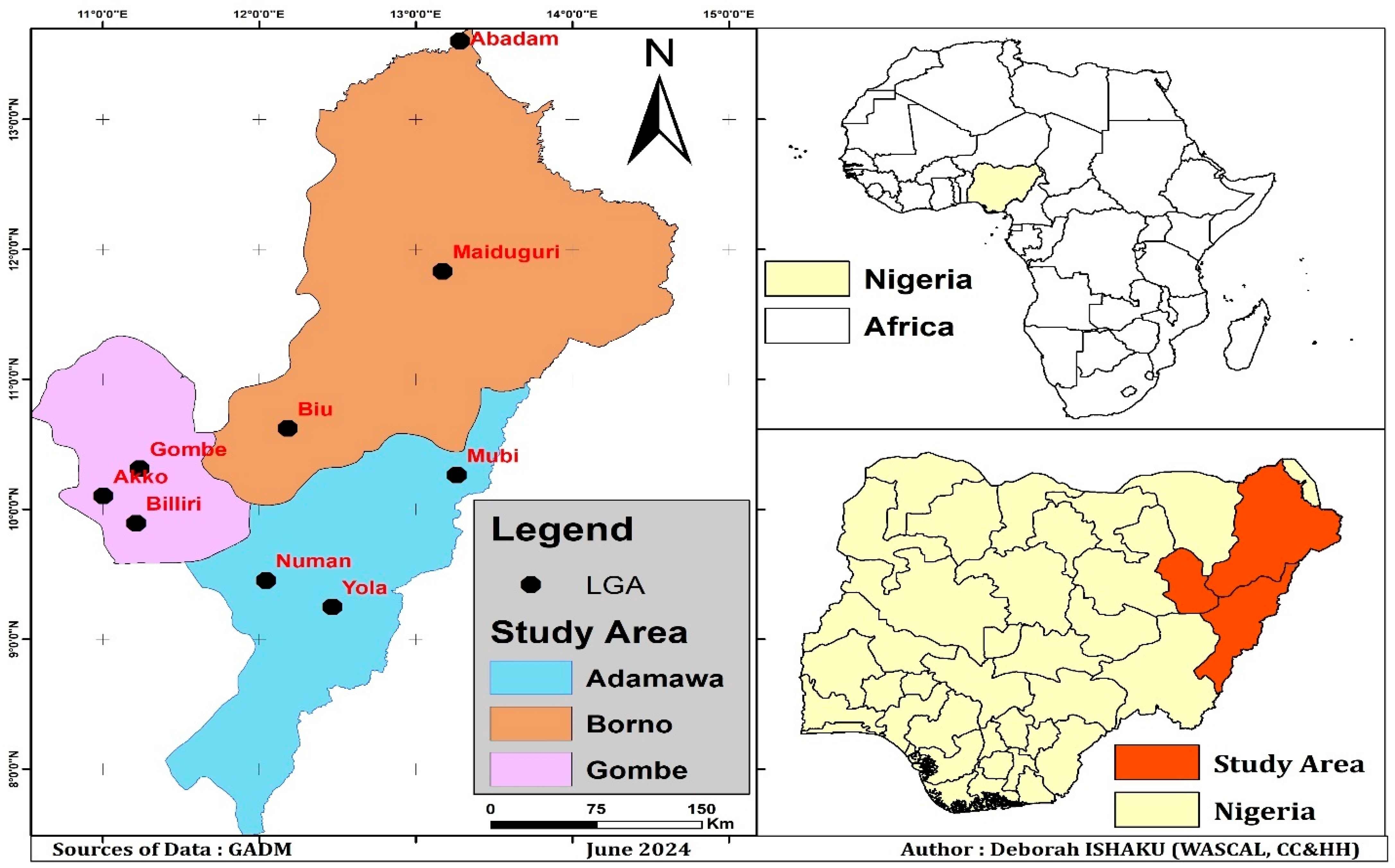
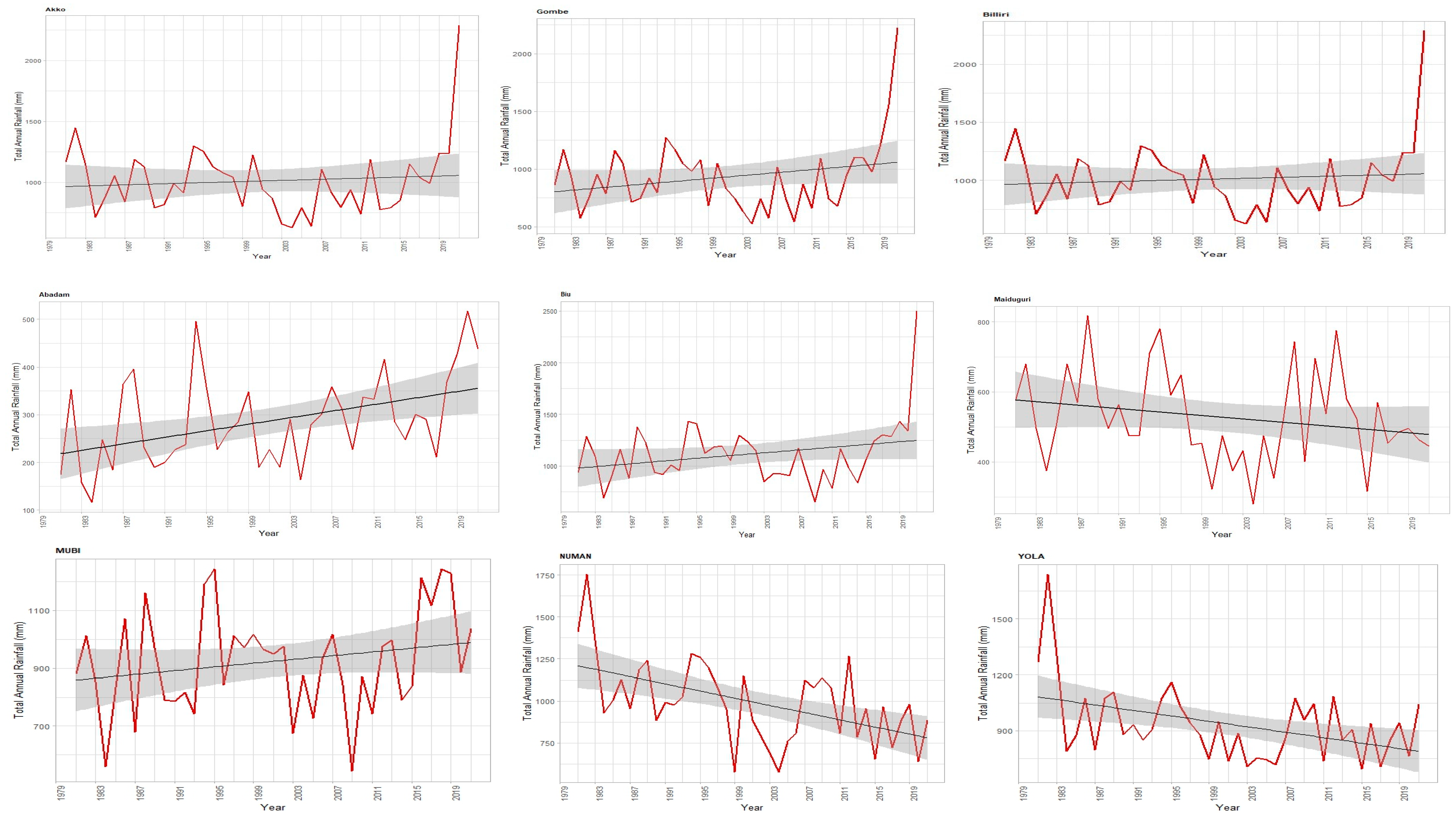
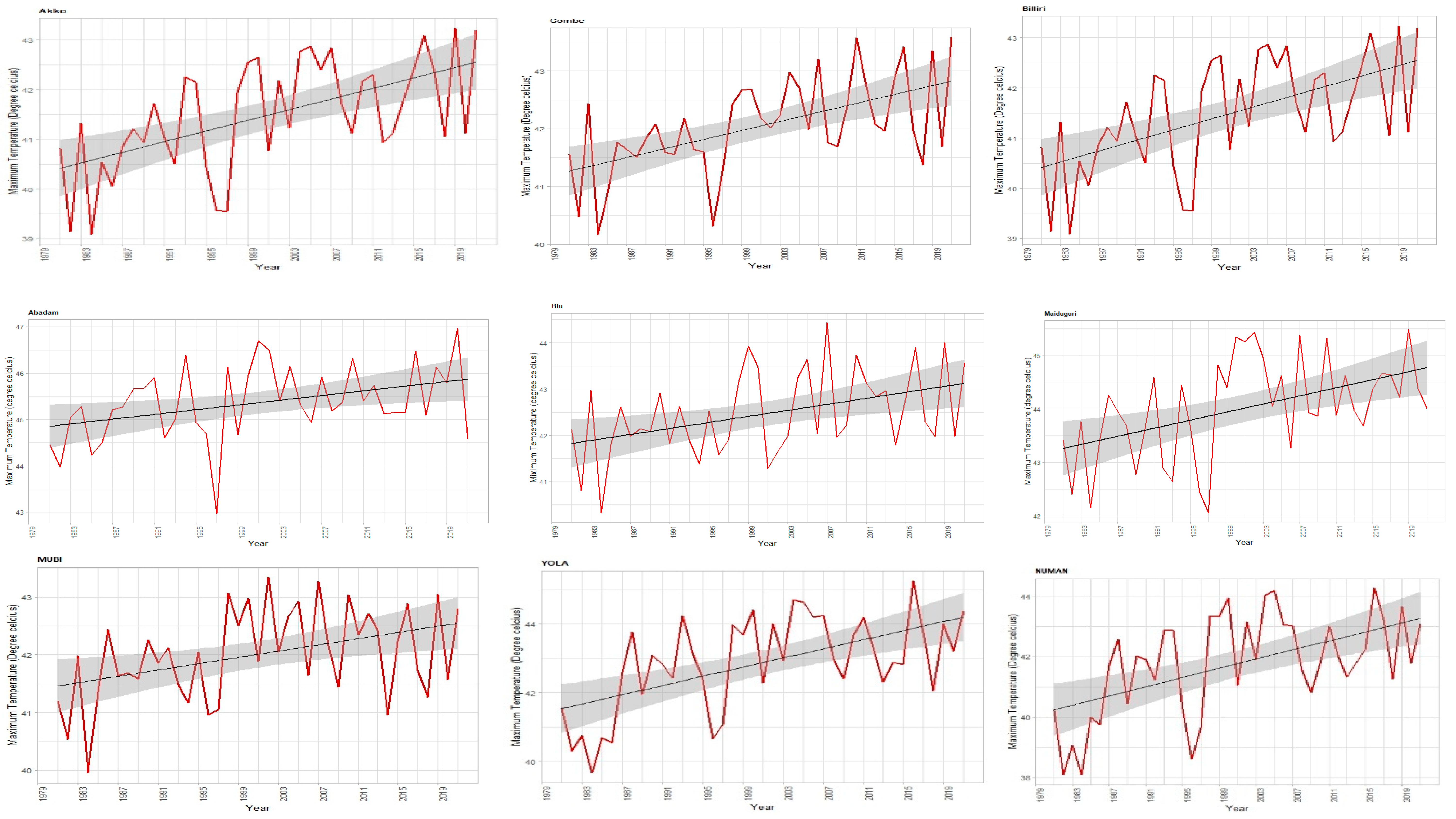

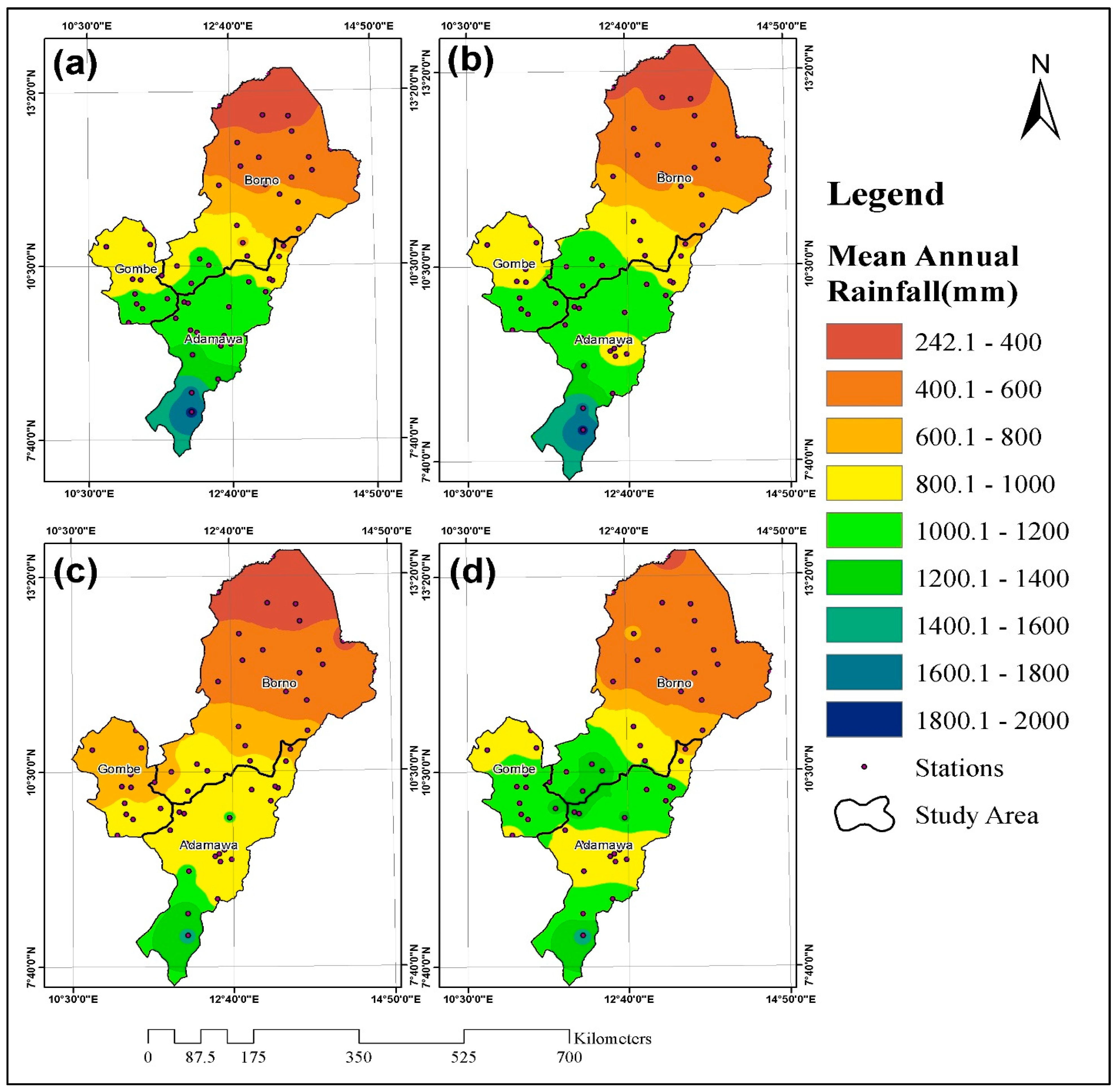
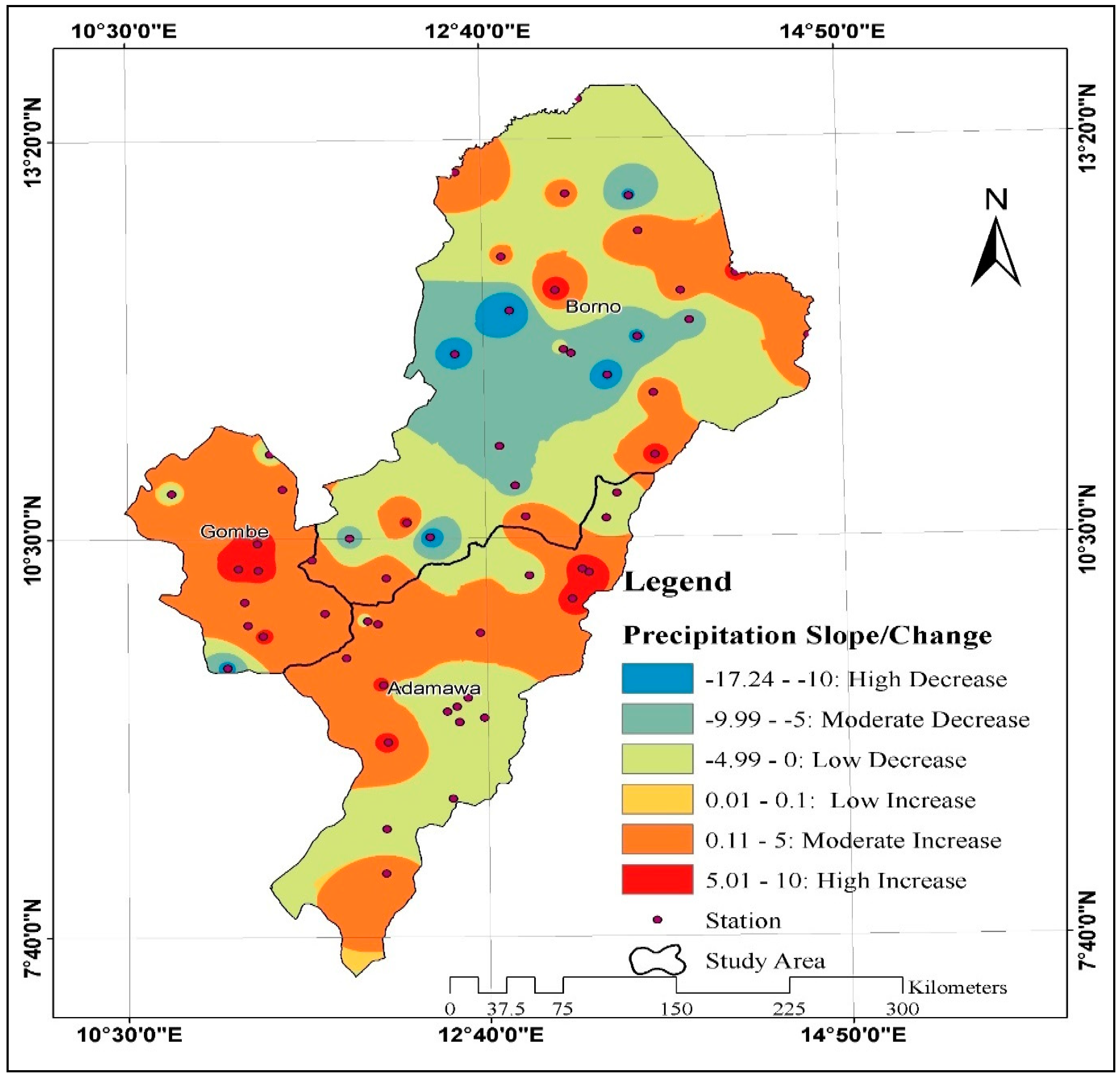
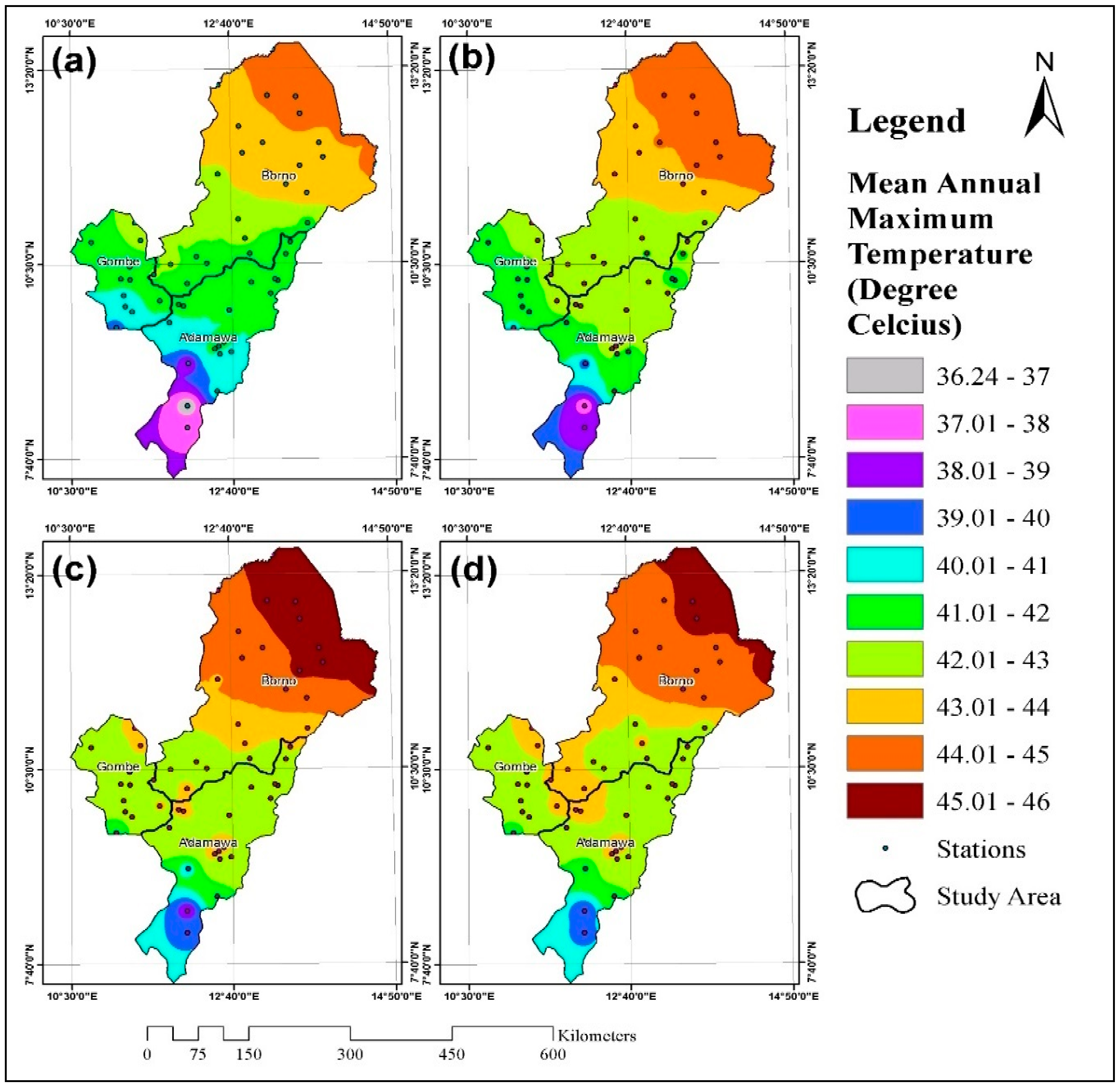
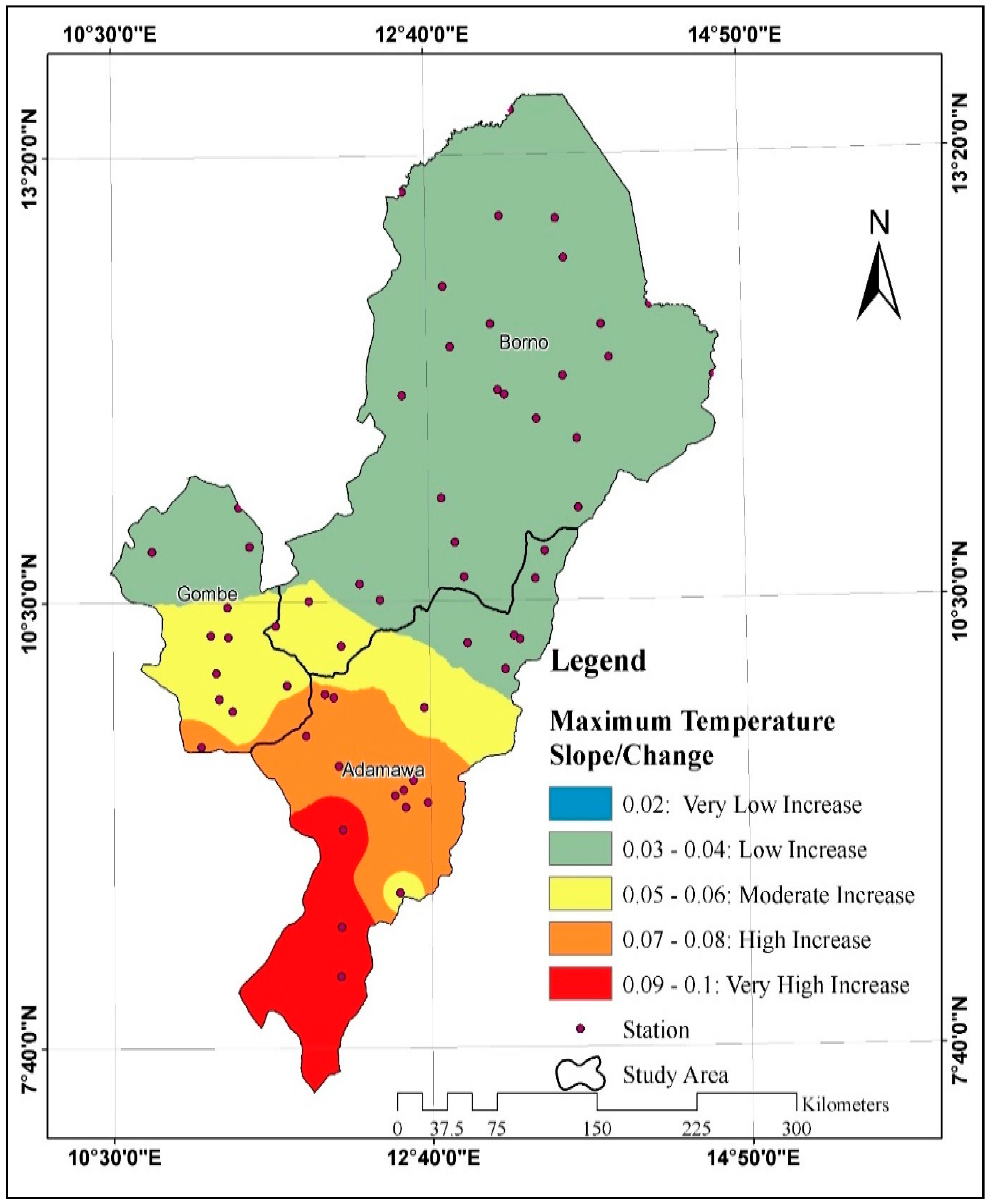
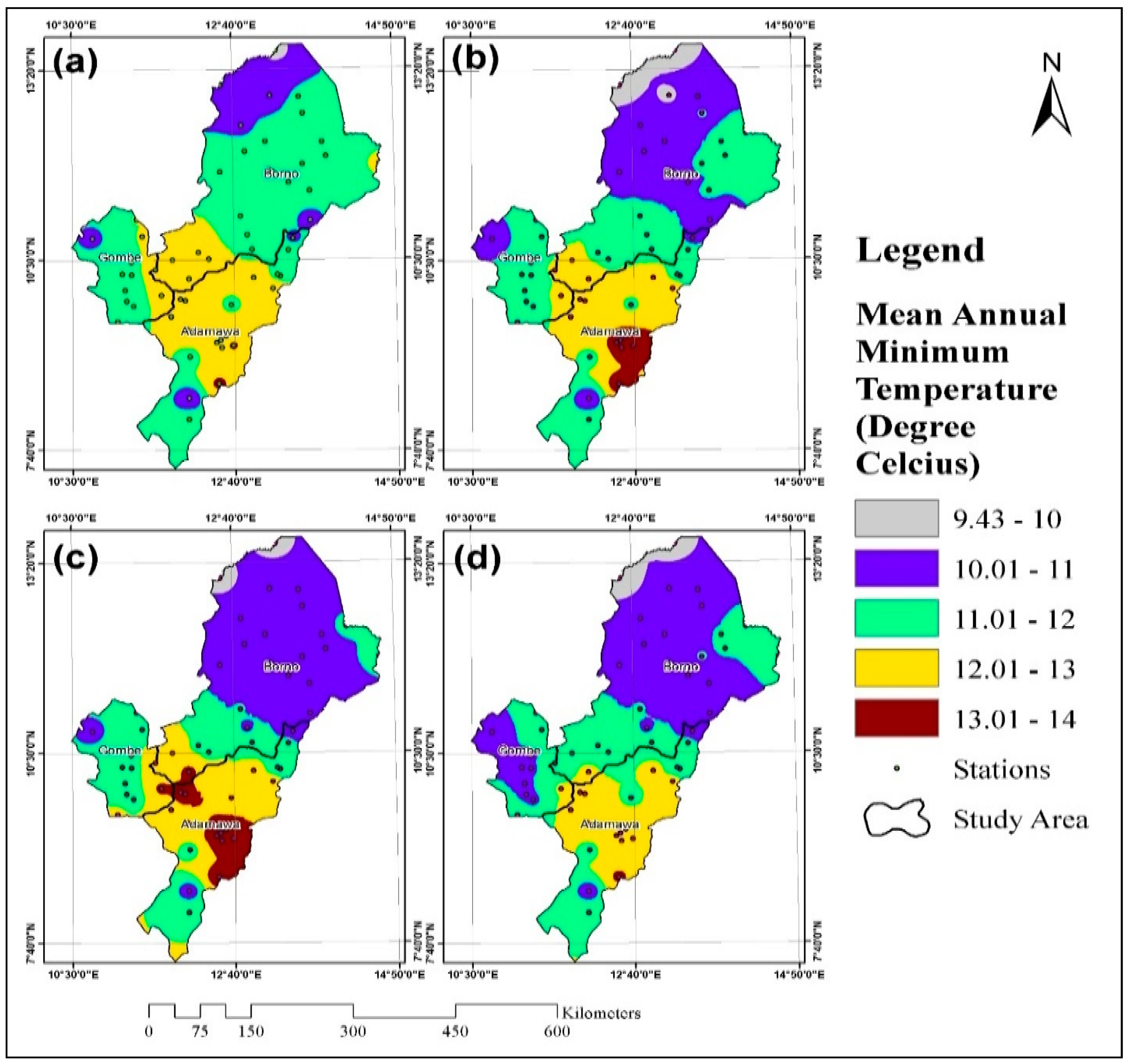
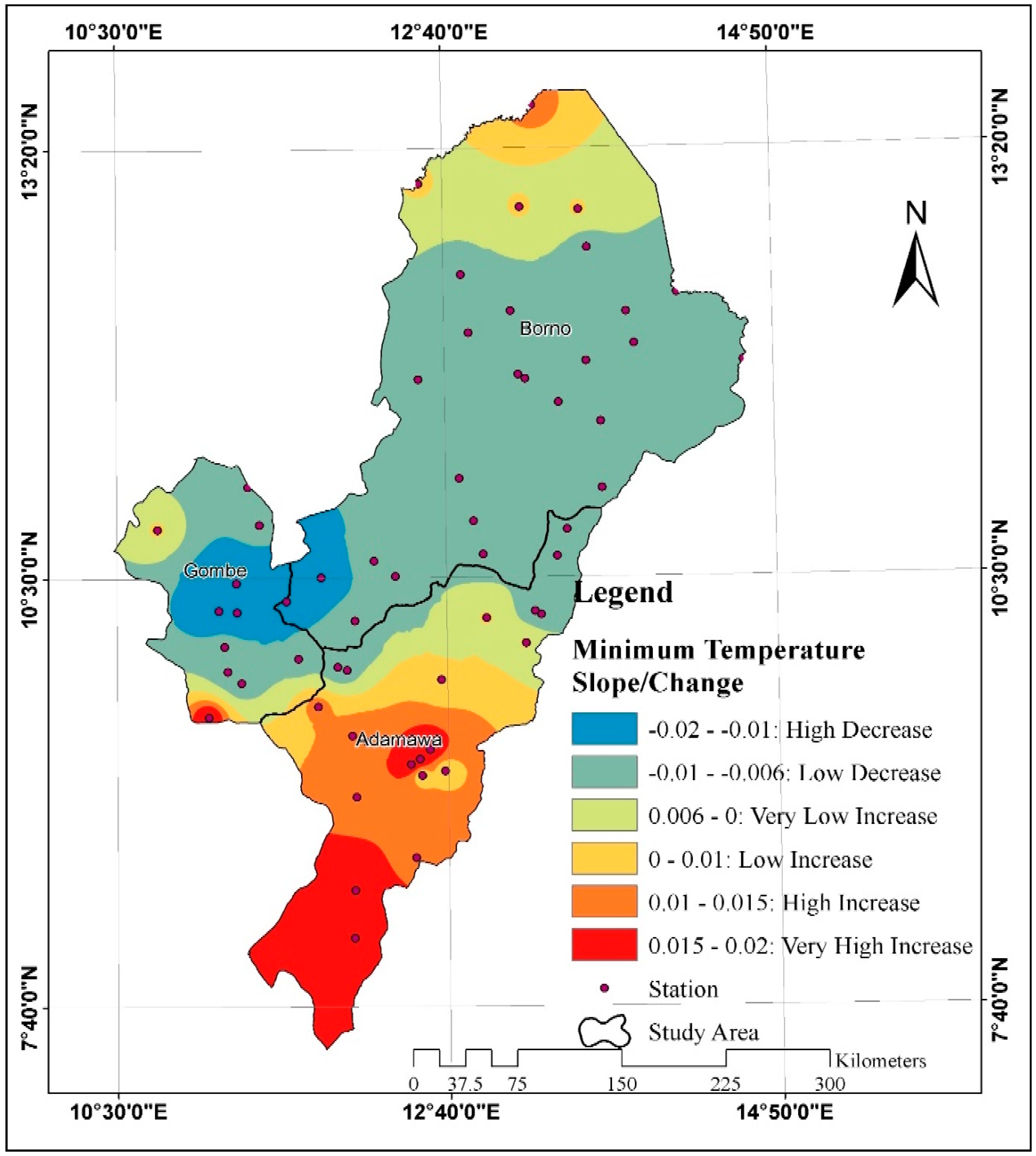
| Station | Kendall’s Tau | Z | p-Value | A |
|---|---|---|---|---|
| Akko | −0.03780 | −0.3371 | 0.7883 ** | 0.05 |
| Gombe | 0.0682 | 0.6180 | 0.6266 ** | 0.05 |
| Billiri | −0.0378 | −0.3371 | 0.7883 ** | 0.05 |
| Abadam | 0.3317 | 3.0472 | 0.0023 * | 0.05 |
| Biu | 0.1317 | 1.2023 | 0.2865 ** | 0.05 |
| Maiduguri | −0.1817 | −1.6643 | 0.0528 ** | 0.05 |
| Mubi | 0.1390 | 1.26985 | 0.2041 ** | 0.05 |
| Numan | −0.3475 | −5.4139 | 0.0000 * | 0.05 |
| Yola | −0.2512 | −2.3046 | 0.0211 * | 0.05 |
| Station | Kendall’s Tau | Z | p-Value | A |
|---|---|---|---|---|
| Akko | 0.4085 | 3.5513 | 0.0003 * | 0.05 |
| Gombe | 0.3951 | 3.6292 | 0.0002 * | 0.05 |
| Billiri | 0.4085 | 3.5513 | 0.0003 * | 0.05 |
| Abadam | 0.2560 | 3.3095 | 0.0009 * | 0.05 |
| Biu | 0.2597 | 2.1563 | 0.0310 * | 0.05 |
| Maiduguri | 0.3195 | 3.7981 | 0.0001 * | 0.05 |
| Mubi | 0.2560 | 2.1192 | 0.0340 * | 0.05 |
| Numan | 0.3524 | 2.5476 | 0.0108 * | 0.05 |
| Yola | 0.3573 | 2.6659 | 0.0076 * | 0.05 |
| Station | Kendall’s Tau | Z | p-Value | A |
|---|---|---|---|---|
| Akko | −0.0609 | −0.5503 | 0.5820 ** | 0.05 |
| Gombe | 0.1658 | −1.5163 | 0.1294 ** | 0.05 |
| Billiri | −0.0609 | −0.5503 | 0.5820 ** | 0.05 |
| Abadam | 0.1256 | 1.6996 | 0.0892 ** | 0.05 |
| Biu | −0.1134 | −1.6555 | 0.0978 ** | 0.05 |
| Maiduguri | −0.0646 | −0.5841 | 0.5591 ** | 0.05 |
| Mubi | −0.0926 | −0.8425 | 0.3995 ** | 0.05 |
| Numan | 0.0426 | 0.3819 | 0.7024 ** | 0.05 |
| Yola | 0.0353 | 0.3145 | 0.7531 ** | 0.05 |
Disclaimer/Publisher’s Note: The statements, opinions and data contained in all publications are solely those of the individual author(s) and contributor(s) and not of MDPI and/or the editor(s). MDPI and/or the editor(s) disclaim responsibility for any injury to people or property resulting from any ideas, methods, instructions or products referred to in the content. |
© 2024 by the authors. Licensee MDPI, Basel, Switzerland. This article is an open access article distributed under the terms and conditions of the Creative Commons Attribution (CC BY) license (https://creativecommons.org/licenses/by/4.0/).
Share and Cite
Ishaku, D.; Umaru, E.T.; Adebayo, A.A.; Löwner, R.; Okhimamhe, A.A. Analysis of the Observed Trends in Rainfall and Temperature Patterns in North-Eastern Nigeria. Climate 2024, 12, 219. https://doi.org/10.3390/cli12120219
Ishaku D, Umaru ET, Adebayo AA, Löwner R, Okhimamhe AA. Analysis of the Observed Trends in Rainfall and Temperature Patterns in North-Eastern Nigeria. Climate. 2024; 12(12):219. https://doi.org/10.3390/cli12120219
Chicago/Turabian StyleIshaku, Deborah, Emmanuel Tanko Umaru, Abel Aderemi Adebayo, Ralf Löwner, and Appollonia Aimiosino Okhimamhe. 2024. "Analysis of the Observed Trends in Rainfall and Temperature Patterns in North-Eastern Nigeria" Climate 12, no. 12: 219. https://doi.org/10.3390/cli12120219
APA StyleIshaku, D., Umaru, E. T., Adebayo, A. A., Löwner, R., & Okhimamhe, A. A. (2024). Analysis of the Observed Trends in Rainfall and Temperature Patterns in North-Eastern Nigeria. Climate, 12(12), 219. https://doi.org/10.3390/cli12120219






